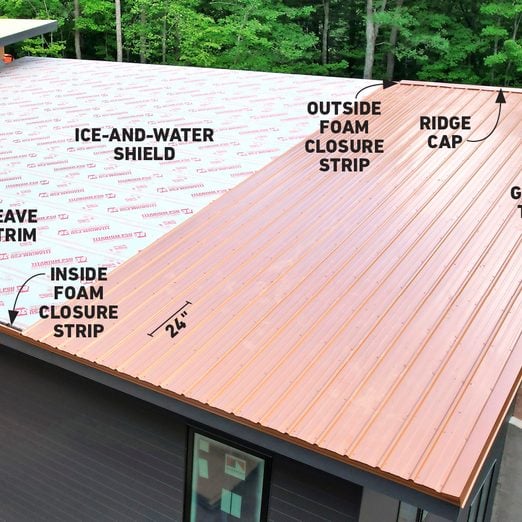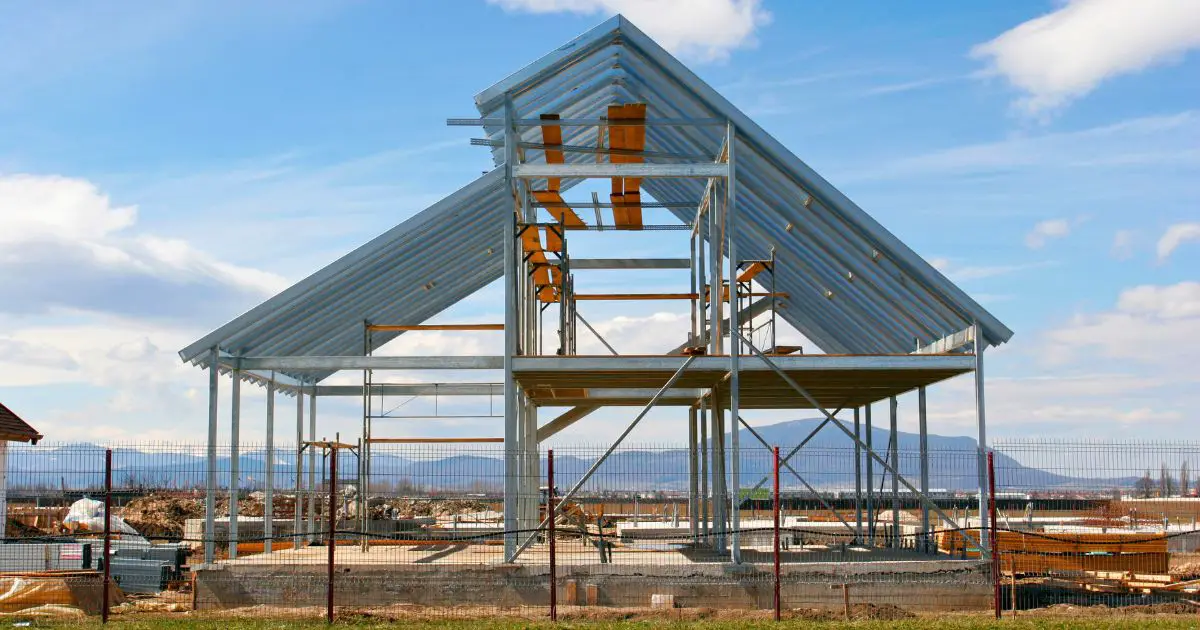To square a metal roof, measure diagonal corners and adjust until measurements match. Proper alignment is essential for a successful roofing installation.
A square metal roof not only enhances the aesthetics but also ensures structural integrity and longevity. Metal roofs have gained popularity for their durability and energy-efficiency. Whether you are installing a new metal roof or replacing an existing one, ensuring it is square is crucial for a seamless and proper fit.
By following the correct measurements and adjustments, you can achieve a perfectly squared metal roof that not only looks visually appealing but also performs effectively in protecting your property against external elements. Let’s dive deeper into the importance of squaring a metal roof and the steps involved in achieving it.
Choosing The Right Materials
When squaring a metal roof, it’s crucial to choose the right materials for the job. Selecting high-quality and durable metal panels, fasteners, and underlayment will ensure a precise and long-lasting installation. Additionally, considering the climate and weather conditions in your area can also help in determining the most suitable materials for squaring a metal roof.
Metal Vs Other Materials
When choosing materials for a metal roof, it’s essential to understand the differences between metal and other roof materials.
Best Type Of Metal For Roofing
To ensure a durable and long-lasting metal roof, select the best type of metal specifically suited for roofing.

Credit: www.familyhandyman.com
Preparation And Safety Measures
When preparing to square a metal roof, it is crucial to prioritize safety measures to prevent accidents and ensure a successful outcome. Proper preparation and adherence to safety protocols are key to completing the task efficiently. This section will delve into the essential steps for Preparation and Safety Measures.
Gathering Proper Tools
Before initiating the process, gather the following tools:
- Metal square
- Tape measure
- Chalk line
- Marker
Safety Gear And Precautions
Ensure you are equipped with the necessary safety gear:
- Hard hat
- Safety goggles
- Gloves
- Non-slip shoes
When working on a metal roof, always maintain a secure footing and avoid working in wet or windy conditions.
Measuring And Cutting Metal Panels
When it comes to squaring a metal roof, one crucial step is measuring and cutting the metal panels. Accurate measurements and precise cutting are essential to ensure a proper fit and a visually appealing end result.
Accurate Measurements
Before you begin cutting the metal panels for your roof, it’s important to take accurate measurements of the area to be covered. Use a reliable measuring tape to ensure precision. Write down the measurements to avoid any confusion during the cutting process.
Using The Right Cutting Tools
https://woodworkingadvisor.com/can-dremels-cut-metal/When cutting metal panels, using the right cutting tools is essential for achieving clean and accurate cuts. A circular saw with a metal cutting blade is a popular choice for this task. Additionally, investing in quality cutting tools can make the process smoother and the results more professional.
Installation Techniques
Proper installation techniques are crucial in achieving a square metal roof that not only enhances the aesthetics of your building but also ensures its durability. In this section, we will explore two essential aspects of installation: panel alignment and fastening, as well as dealing with sloped areas.
Panel Alignment And Fastening
When it comes to panel alignment, maintaining a straight and even layout is key. This not only creates a visually pleasing appearance but also prevents future problems such as water leakage or damage to the roofing system. To achieve this, follow these steps:
- Start by measuring and marking the centerline of the roof. This will serve as your reference point throughout the installation process.
- Align the first panel with the centerline, making sure it is square to both the eave and rake edges of the roof.
- Secure the panel using appropriate fasteners, ensuring they are evenly spaced and properly seated to hold the panel securely in place.
- Continuously check the alignment of subsequent panels against the centerline, using a level tool to guarantee a straight and level installation. Make adjustments if necessary.
- Repeat the above steps for each row of panels, maintaining consistent alignment and fastening techniques.
Dealing With Sloped Areas
Sloped areas of a metal roof can pose a unique challenge during installation. Here’s how to address them:
- Measure the slope of the area accurately to determine the angle at which panels should be cut.
- Use a straight edge or a metal roofing tool to mark the panels according to the calculated angle.
- Carefully cut the panels using appropriate tools, such as metal shears or a circular saw with a metal cutting blade.
- Attach the cut panels, ensuring they align with adjacent panels and the overall layout of the roof.
- Inspect the sloped areas for any gaps or unevenness that may compromise the integrity of the roofing system. Take corrective measures as needed.
By following these installation techniques, you can achieve a square metal roof that not only enhances the structural integrity of your building but also provides a visually appealing finish.
Finishing Touches And Maintenance
Once you have successfully squared your metal roof, it’s time to focus on the finishing touches and maintenance to ensure its longevity and durability. By taking the necessary steps to seal and waterproof your roof, as well as following some key maintenance tips, you can ensure that your metal roof stays in great condition for years to come.
Sealing And Waterproofing
Sealing and waterproofing your metal roof is essential to protect it from the elements and prevent any potential leaks or damage. Here are some important steps to follow:
- Inspect the seams and joints of your metal roof carefully to identify any areas that may need sealing. Look for any gaps or cracks that could allow water to penetrate.
- Fill in any gaps or cracks with a high-quality, weather-resistant sealant. Make sure to choose a product that is specifically designed for metal roofs.
- Apply the sealant evenly along the seams and joints using a caulking gun, ensuring complete coverage and a watertight seal.
- Allow the sealant to dry and cure according to the manufacturer’s instructions before exposing the roof to any rainfall or moisture.
- Regularly inspect the sealed areas for any signs of wear or deterioration, and reapply sealant as needed to maintain a strong and effective seal.
Maintenance Tips For Longevity
In addition to proper sealing and waterproofing, regular maintenance is crucial for ensuring the longevity of your metal roof. Consider the following tips:
- Clean your roof regularly to remove any debris, leaves, or other materials that can accumulate over time. Use a soft-bristle broom or a low-pressure hose to avoid scratching or damaging the metal surface.
- Check for any loose or damaged panels and fasteners. Tighten or replace them as necessary to maintain the structural integrity of your roof.
- Inspect the roof for any signs of rust or corrosion. If you notice any, remove it using a wire brush or sandpaper, and apply a rust-inhibiting primer and paint to prevent further damage.
- Keep nearby trees trimmed and ensure that branches do not touch or rub against the roof. This will prevent any potential scratching or damage from branches during strong winds or storms.
- Regularly check your attic or ceiling for any signs of water stains or leaks. Address any issues immediately to prevent further damage to your roof and the interior of your home.
By following these sealing and maintenance tips, you can keep your metal roof in excellent condition and extend its lifespan. Remember to regularly inspect, clean, and address any issues promptly, and your metal roof will provide reliable protection for your home for many years to come.

Credit: www.wikihow.com
Frequently Asked Questions Of How To Square A Metal Roof
How Do You Square A Metal Roof?
To square a metal roof, start by finding the diagonal measurements from opposite corners. Adjust the roof until both diagonal measurements are equal. Use a framing square to ensure the roof is at right angles. Secure the roof in place by fastening it to the framing beneath.
Why Is It Important To Square A Metal Roof?
Squaring a metal roof is crucial for proper installation. It ensures the roof is straight, aligned, and symmetrical, which improves its appearance and also prevents future problems such as leaks and structural issues. A perfectly squared roof also allows for easy installation of other roofing components, such as gutters and flashing.
What Tools Are Needed To Square A Metal Roof?
To square a metal roof, you will need a measuring tape, a framing square, chalk or marking tool, and fasteners such as screws or nails. These tools will help you measure and mark the roof accurately, ensuring precise alignment and a square installation.
Conclusion
In closing, squaring a metal roof is essential for a successful roofing project. By following the steps outlined in this guide, you can ensure that your metal roof is installed correctly and will provide long-lasting protection for your home. Remember to measure carefully, use the right tools, and take your time to achieve the best results.
With proper technique and attention to detail, you can create a sturdy and durable metal roof that will stand the test of time.



One thought on “How to Square a Metal Roof Like a Pro: Expert Tips and Tricks”